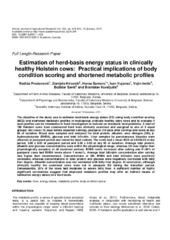Приказ основних података о документу
Estimation of herd-basis energy status in clinically healthy Holstein cows: Practical implications of body condition scoring and shortened metabolic profiles
| dc.creator | Prodanović, Radiša | |
| dc.creator | Kirovski, Danijela | |
| dc.creator | Šamanc, Horea | |
| dc.creator | Vujanac, Ivan | |
| dc.creator | Ivetić, Vojin | |
| dc.creator | Savić, Božidar | |
| dc.creator | Kureljušić, Branislav | |
| dc.date.accessioned | 2022-11-14T09:40:38Z | |
| dc.date.available | 2022-11-14T09:40:38Z | |
| dc.date.issued | 2012 | |
| dc.identifier.issn | 1991-637X | |
| dc.identifier.uri | https://vet-erinar.vet.bg.ac.rs/handle/123456789/2490 | |
| dc.description.abstract | The objective of the study was to estimate herd-basis energy status (ES) using body condition scoring (BCS) and shortened metabolic profiles in multiparous clinically healthy dairy cows and to evaluate if such profiles can be informative in herd investigation to indicate on metabolic herd problems. A total of 180 Holstein cows from commercial herd were clinically examined and assigned to one of 3 equal groups: dry cows (15 days before expected calving), puerperal (10 days after calving) and cows at day 60 of lactation. Blood were sampled and analyzed for total protein, albumin, urea nitrogen (UN), β-hydroxybutyrate (BHBA), glucose and total bilirubin. Liver samples by percutaneous biopsies were obtained at puerperal period and tested for lipid content. The cows had a mean BCS of 3.92±0.03 at dry period, 3.08 ± 0.03 at puerperal period and 2.82 ± 0.02 at day 60 of lactation. Average total protein, albumin and glucose concentrations were within the physiological range, whereas UN was higher than physiologically accepted, at all examined periods. BHBA levels increased after calving and 61.66% of puerperal cows had BHBA levels above 1 mmol/L. Average total bilirubin concentration after calving was higher than recommended. Concentrations of UN, BHBA and total bilirubin were positively correlated, whereas concentrations of total protein and glucose were negatively correlated with fatty liver degree. Albumin concentration was not correlated with fatty liver degree. In conclusion, although clinically healthy the examined cows were not in adequate ES during the transition period. Consequently, 55% of the cows had moderate to severe fatty liver. A sufficient number of highly significant correlations suggest that employed metabolic profiles may offer an indirect means of estimation energy status on a herd basis. | sr |
| dc.language.iso | en | sr |
| dc.publisher | Academic Journals | sr |
| dc.relation | info:eu-repo/grantAgreement/MESTD/Technological Development (TD or TR)/31062/RS// | sr |
| dc.relation | info:eu-repo/grantAgreement/MESTD/Integrated and Interdisciplinary Research (IIR or III)/46002/RS// | sr |
| dc.rights | openAccess | sr |
| dc.rights.uri | https://creativecommons.org/licenses/by/4.0/ | |
| dc.source | African Journal of Agricultural Research | sr |
| dc.subject | Cow | sr |
| dc.subject | energy status | sr |
| dc.subject | metabolic profile | sr |
| dc.subject | body condition score | sr |
| dc.title | Estimation of herd-basis energy status in clinically healthy Holstein cows: Practical implications of body condition scoring and shortened metabolic profiles | sr |
| dc.type | article | sr |
| dc.rights.license | BY | sr |
| dc.citation.volume | 7 | |
| dc.citation.spage | 418 | |
| dc.citation.epage | 425 | |
| dc.citation.rank | M23 | |
| dc.identifier.doi | 10.5897/AJAR11.1432 | |
| dc.identifier.fulltext | http://veterinar.vet.bg.ac.rs/bitstream/id/7133/document.pdf | |
| dc.type.version | publishedVersion | sr |

